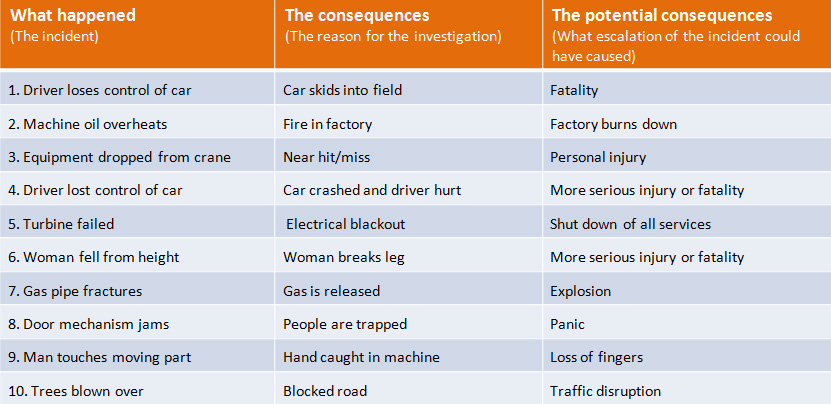
The Incident Statement is prepared right at the beginning of the investigation. It is a definition of the problem that you are going to investigate and analyse. This, of course, is developed as the starting point of the investigation. The same statement is used throughout the whole investigation and is also the starting point for the Root Cause Analysis. To obtain the Incident Statement, consider why the investigation was required in the first place. e.g.
It is clear that events such as these will require investigation.
It is these Consequences that make the investigation necessary. However, a complete Incident Statement has three parts:
We always know all, or most of, the Consequences that made the investigation necessary, we need to identify What Happened that initiated the event that is to investigated e.g
Clearly in any investigation it may be difficult to define What Happened. However, do write your best estimate. It is possible to change this in the light of new facts emerging during the investigation. Never the less it is likely that your first statement will be correct. By the time you start your Root Cause Analysis diagram you will have facts from your investigation, so there should be no doubt at that point about What Happened.
As you should have already learned from working through this e-learning module, the Immediate Causes will are developed directly from the What Happened and The Consequences parts of the Incident Statement. It is very important to get this correct as it governs the whole direction of the investigation and subsequent analysis.
The most difficult part of Root Cause Analysis is always getting started and the two essential first steps are writing the Incident Statement and then establishing the Immediate Causes. One leads into the other. Once you have clearly established these first two steps, producing the remainder of the diagrams should logically flow using the facts that you have established during your investigation.
Somewhat easier is the writing of the Potential Consequences. Here we are stating what could have occurred if the incident had escalated e.g.
As you can see, the Potential Consequences usually have the greater significance.
e.g. An aircraft 'near miss' will have such high Potential Consequences that it will trigger a full official investigation. Another example could be a gas release where nothing actually happened, but the potential for a major explosion existed. However, these examples are exceptional, so do be careful not to over complicate your investigation and analysis, or to exaggerate.
Some example incident statements:
